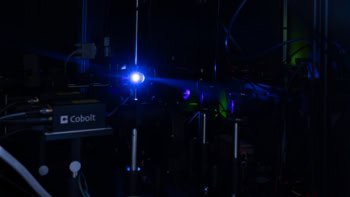
While antiferromagnets show much promise for spintronics applications, they have proved more difficult to control compared to ferromagnets. Researchers in Japan have now succeeded in switching an antiferromagnetic manganese–tin nanodot using electric current pulses as short as 0.1 ns. Their work shows that these materials can be used to make efficient high-speed, high-density, memories that operate at gigahertz frequencies, so outperforming ferromagnets in this range.
In antiferromagnets, spins can flip quickly, potentially reaching frequencies well beyond the gigahertz. Such rapid spin flips are possible because neighbouring spins in antiferromagnets align antiparallel to each other thanks to strong interactions among the spins. This is different from ferromagnets, which have parallel electron spins.
Another of their advantages is that antiferromagnets display almost no macroscopic magnetization, meaning that bits can be potentially packed densely onto a chip. And that is not all: the values of bits in antiferromagnetic memory devices are generally unaffected by the presence of external magnetic fields. However, this insensitivity can be a disadvantage because it makes the bits difficult to control.
Faster than ferromagnets
In the new work, a team led by Shunsuke Fukami of Tohoku University made a nanoscale dot device from the chiral antiferromagnet Mn3Sn. They were able to rapidly and coherently rotate the antiparallel spins in the material using electric currents with a pulse length of just 0.1 ns at zero magnetic field. This is faster than is possible in any existing ferromagnetic device, they say.
The device is also capable of 1000 error-free switching cycles – a level of reliability not possible in ferromagnets, they add.
This result is possible because, unlike conventional antiferromagnets, Mn₃Sn exhibits a large change in electrical resistance thanks to its unique symmetry of the internal spin texture, explains Yutaro Takeuchi, who is lead author of a paper describing the study. “This effect provides us with an easy method for electrically detecting (reading out) the antiferromagnetic state. Doing this is usually difficult because antiferromagnets are externally ‘invisible’ (remember, they have zero net magnetization), which means their spin ordering cannot be easily read out.”
Until now, Mn₃Sn had mainly been studied in bulk samples, but in 2019, Fukami’s group succeeded in growing epitaxial thin films of the material. “This allowed us to perform clear-cut experiments using antiferromagnetic thin films and finally answer the question: can antiferromagnets really outperform their ferromagnetic cousins?” says Takeuchi. “Moreover, in this study, we took on the additional challenge of integrating antiferromagnetic thin films into nanoscale devices.”
New types of devices could be possible
Fukami and colleagues have been working on spintronics using ferromagnets for more than 20 years. “Although the fabrication of antiferromagnets was initially difficult, we finally managed to produce high-quality Mn₃Sn nanodot devices and demonstrated high-speed and high-efficiency control of the antiferromagnetic state,” Takeuchi tells Physics World. “We would say that our work represents a fusion of our two key strengths: a new method for depositing antiferromagnetic thin films and our conventional core technology in the nanofabrication of magnetic materials.”
As for potential applications, the most likely would be a high-performance non-volatile memory (MRAM), he says. “While MRAM technology is now commercially available, its applications remain limited. By further improving its high-speed and low power consumption, we anticipate a broader range of markets, including data centres and AI chips.”

Terahertz light produces a metastable magnetic state in an antiferromagnet
The research, which is detailed in Science, has also highlighted some dynamical aspects of antiferromagnets not seen before in ferromagnets. “In particular, we found that the rotation frequency of an antiferromagnet can be modulated by an applied current, thanks to the unique dynamical equation it obeys,” explains Yuta Yamane, who did the theoretical modelling part of the study. “This distinct property may open the door to new types of devices, such as frequency-tuneable oscillators, and emerging concepts like probabilistic computing.”
Looking ahead, the team will now focus on improving the readout performance of antiferromagnets and pursuing new functionalities. “Thanks to their unique transport properties, chiral antiferromagnets allow us to detect spin ordering in experimental settings, but the readout performance has still not reached the level of ferromagnets,” says Takeuchi. “A breakthrough will be required to overcome this gap.”



